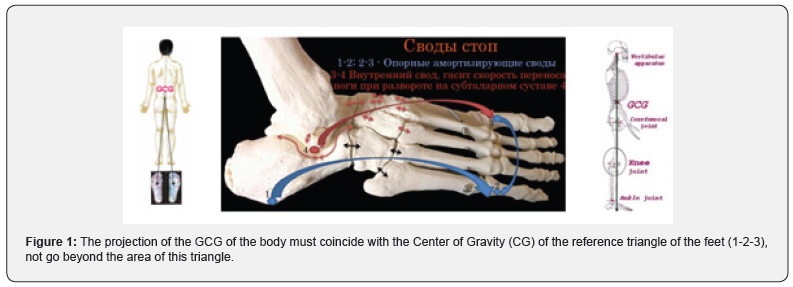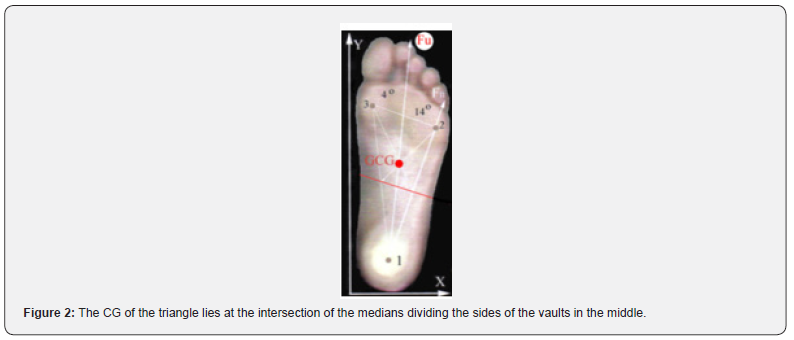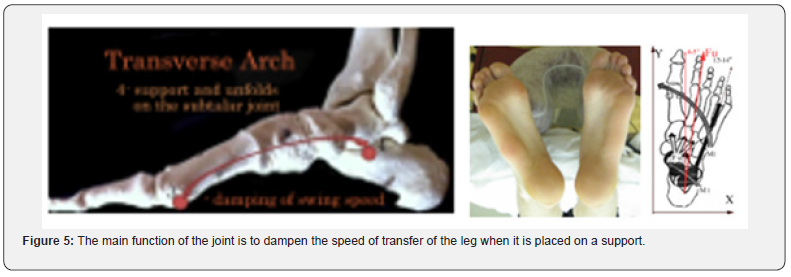What is Foot Deformity and Correction
Valentyn Gusyev*
Doctor of Natural Medicine, Osteopathy at Scientific Research Centre of Functional Orthopaedics, Canada
Submission: May 31, 2023; Published: August 08, 2023
*Corresponding author: Valentyn Gusyev, Doctor of Natural Medicine, Osteopathy at Scientific Research Centre of Functional Orthopaedics, Canada Email: gusyevval@hotmail.com
How to cite this article: Valentyn G. What is Foot Deformity and Correction. J Head Neck Spine Surg. 2023; 5(1): 555653. DOI: 10.19080/JHNSS.2023.05.555653
Keywords: General Center of Gravity; Feet; Arches of the Feet; Muscles; Cuboid Bones; Plantar Aponeurosis; Subtalar Joint; Body Cells
Opinion
The deformation of the feet is the result of the action of the load, the mass of the body reduced to the General Center of Gravity (GCG) of the body, its position relative to the points of support of the arches of the feet. The displacement of the GCG relative to the vertical axis of the body is determined by the presence of an anatomical difference in the lengths of the legs, which leads to a skew of the pelvis, the formation of functional displacements of bones in the joints of the skeleton to the level of the head, and a violation of the contractile pumping function of the muscles.
The projection of the GCG of the body must coincide with the Center of Gravity (CG) of the reference triangle of the feet (1-2-3), not go beyond the area of this triangle (Figure 1). The CG of the triangle lies at the intersection of the medians dividing the sides of the vaults in the middle. These are the highest points of the arches of the vaults through which the load passes (Figure 2). The external supporting arch (1-2) consists of the calcaneus and cuboid bones and two metatarsals (Figure 3). They form 2 joints, along one of which, from the heel side, the cuboid bone can move down until it touches the supporting surface. This is the key moment of depreciation - stretching of the plantar aponeurosis and the beginning of the turn of the internal arch on the subtalar joint of the calcaneus. The reference points of the arch are the tubercle of the calcaneus (1) and the metatarsal head (2). The cuboid bone is the highest point of the vault.





The fulcrum of the transverse support arch (2-3) are the heads of the first and fifth metatarsals (Figure 4). The load passes between heads 2 and 3 metatarsal. These two support vaults determine the position of the body’s BCT relative to the XY support surface.
The internal arch (3-4) consists of the talus, which forms the subtalar joint with the calcaneus, the scaphoid, and three sphenoid and metatarsal bones each. The main function of the joint is to dampen the speed of transfer of the leg when it is placed on a support (Figure 5). This is a large braking distance carried out when turning the arch on the subtalar joint. The beginning of this turn is the contact of the cuboid bone with the surface of the support.
To correct, to eliminate the turn of the internal arch, which is taken for flat feet, means to put the cuboid bone in the upper position, raise the cuboid bone to the upper position, giving the arch an arched shape, bringing the muscle into a neutral balanced state (Figure 6). This means that the vertical load on the vaults from top to bottom (body weight) must be compensated by forces directed from bottom to top. So, standing on the diaphragms of the communicating vessels of the installation, the body hangs in a stable vertical position, the pressure under the feet and on the soles is equalized and the anatomical difference in leg lengths is compensated (Figure 7). This difference is recorded by positive footprints, which is finally compensated for on the finished insoles while standing on the measuring device.



The result of such a correction of the feet and overlying structures of the skeleton is the normalization of the metabolic processes of body cells (Figure 8), which manifests itself in the normalization of arterial blood flow, the disappearance of the feeling of cold feet, cramps in the muscles of the legs, cleansing of the skin of the face and body, and the absence of symptoms of chronic diseases of various kinds.






























